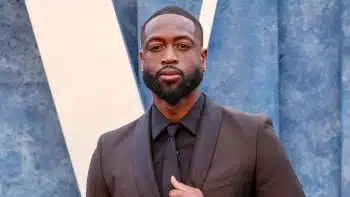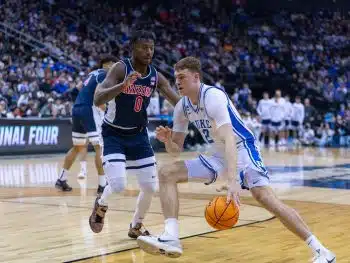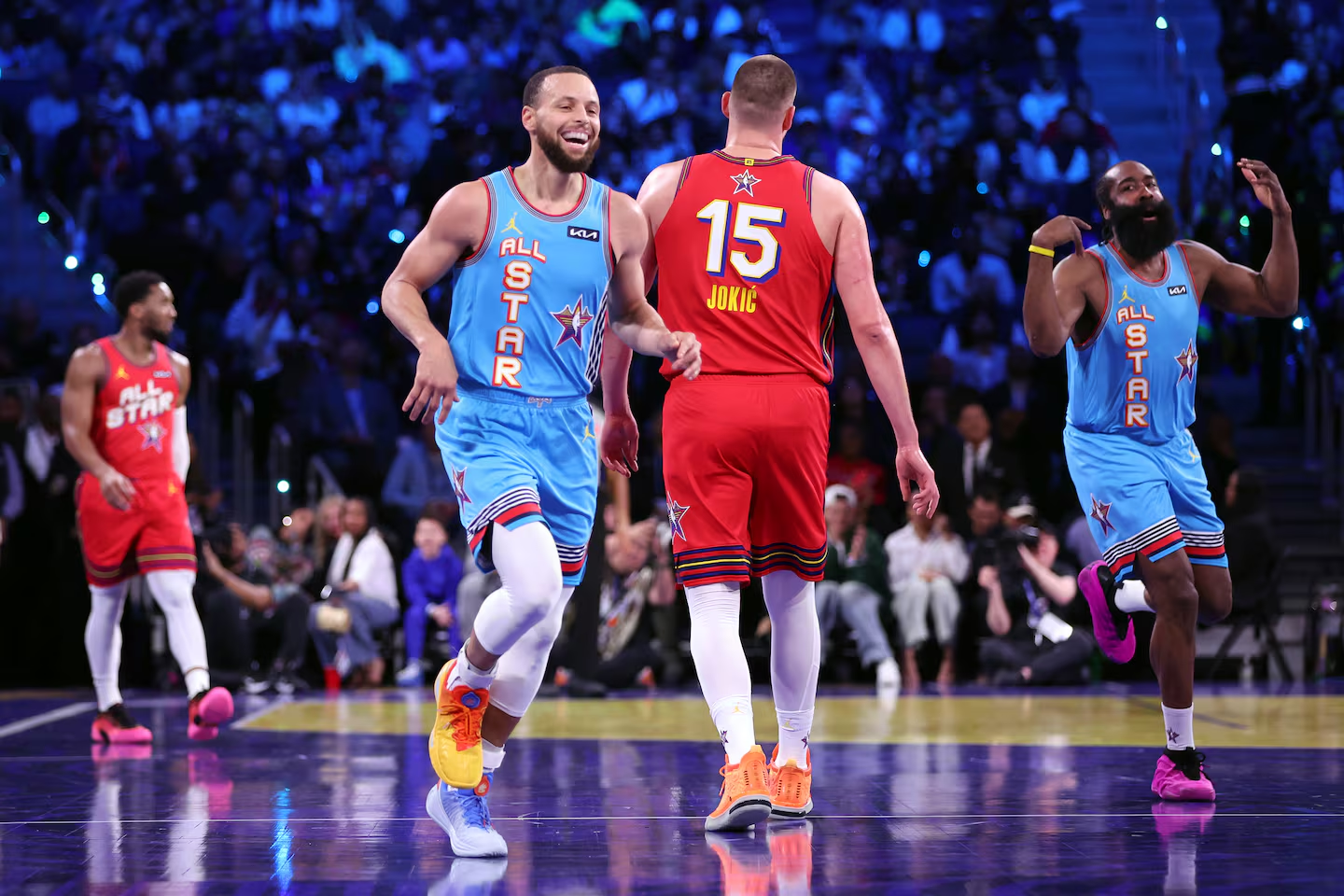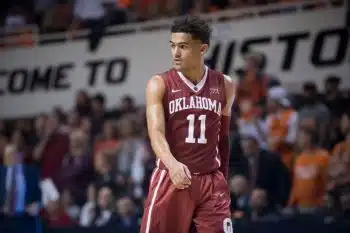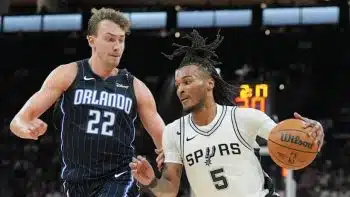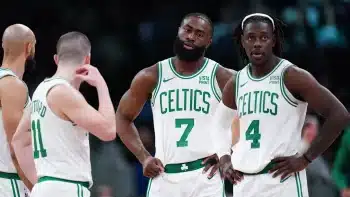NBA
Minnesota Timberwolves 2019-20 NBA Season Preview
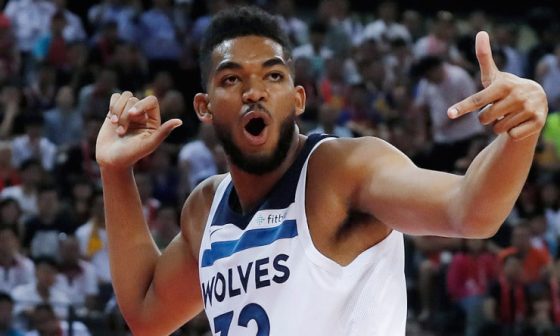
After another up and down season, the Timberwolves find themselves looking at a defining season in 2019-20. There is new leadership in place that is not tied to anyone on the roster, and all of the contracts and commitments made came from the previous regime, which means everyone starts with a clean slate.
That said, the clock is ticking on All-Star Karl-Anthony Towns, who is entering the first season of his 5-year, $190 million extension signed in 2018. Modern NBA history says All-Stars won’t stay committed long if they don’t have a chance to win and win big, which put the pressure squarely on the new front office to turn the ship.
To say this is an important season for the future of the Wolves is an understatement.
The Wolves missed the playoffs last year by 12 games and are returning functionally the same roster, which means if things are going to change its going to have to come from internal growth or a mid-season trade. The outcome of the first half of the season could answer that question either way. The Wolves have solid players, the question is can they put it together?
Let’s take a look at the Minnesota Timberwolves in this 2019-20 NBA Season Preview.
FIVE GUYS THINK…
The Timberwolves are in serious need of a second star. Karl Anthony-Towns should continue to be productive, but even he needs to continue to develop – mostly on the defensive end of the floor. They were pleasantly surprised last season with the play and motor of Josh Okogie, who will be relied on even more so this season. Rookie Jarrett Culver projects to be a strong two-way player with a versatile offensive game – he should be another positive for the Wolves. And there is good depth in Noah Vonleh, Jeff Teague, Robert Covington and Keita Bates-Diop. But the lack of efficiency and effort from Andrew Wiggins has hurt the T-Wolves developmental trajectory. As has been the case for a number of years now, if he improves his three-point shooting, shot selection, and defense, the Wolves have the potential to be a very different team. As currently constructed, they’re going to struggle to keep up with the best in the West.
4th Place – Northwest Division
– Drew Maresca
We’re entering another year with Karl-Anthony Towns and Andrew Wiggins as the focal points of the Wolves. Are there more expectations or less? Jimmy Butler is not around anymore, nor is Tom Thibodeau. Ryan Saunders is taking over and following in his late, great father’s footsteps. Can the 33-year-old continue to galvanize this underperforming franchise and turn it into a contender? Stocked with a plethora of forwards, the roster could make it difficult to do so this season. But with a mixture of veteran talent and interesting prospects, there might be a culture shift in Minnesota – and it will prove to be the mark of a new era. As a part of one of the toughest divisions in the NBA, it’s hard to see this team playing in the postseason, though.
4th Place – Northwest Division
– Spencer Davies
The Timberwolves have one incredibly good thing going for them, and that’s Karl-Anthony Towns. He is a superstar and, luckily for the Wolves, they have him locked in for the next several years. After him though, the rest of the team is kind of a question mark. Robert Covington emerged as arguably the second-best player on the team, but his season was cut short due to injury. They lost some of their bench depth in Tyus Jones and Taj Gibson, and they’re looking to Jordan Bell and Shabazz Napier to fill those roles. What they really need though is Andrew Wiggins to play like the max contract guy the Wolves believed they had. He was once thought to be a budding star, but he’s been wildly inconsistent to say the least. If he plays as he should, maybe the Wolves challenge for the eighth seed. If not, look for another lottery finish.
4th Place – Northwest Division
– David Yapkowitz
Things have to turn for the Timberwolves right? There is simply too much talent in Minnesota for them to be a team that’s outside the playoff picture. New team president Gersson Rosas resisted the temptation to blow things up in Minnesota, and beyond some minor changes, the bulk of last year’s team is coming back, as is Ryan Saunders at head coach. That could either make this the beginning of the end, or the turning point for the youth on the roster. There is little doubt Karl-Anthony Towns is the franchise cornerstone, but if Andrew Wiggins doesn’t step up on a night to night basis, he could be gone by the trade deadline and that could start a tidal wave of changes. The Wolves have the talent to be a playoff team, the question is can they be consistent and healthy enough to cement themselves in the 7-8 seed discussion?
4th Place – Northwest Division
– Steve Kyler
It’s a bit difficult to assess the Minnesota Timberwolves’ offseason. I like a lot of the smaller moves Minnesota made but I think the team may have missed the mark on what could end up being the biggest move of its offseason. I liked that Minnesota traded Dario Saric and the rights to Cameron Johnson (11th) to the Phoenix Suns for the sixth overall pick in this year’s draft. However, rather than addressing the team’s point guard situation by drafting Coby White, Minnesota drafted Jarrett Culver. Culver is a talented player, but White is the better prospect in my opinion and could have been the long-term solution for a major area of need for this team. Having said that, I like that the team locked in Ryan Saunders at head coach, signed Noah Vonleh to a $2 million contract, signed Jordan Bell to a minimum contract (notably Bell will again be a restricted free agent after this upcoming season), acquired Shabazz Napier ($1,845,301 guaranteed for 2019-20), and claimed Tyrone Wallace off of waivers. Minnesota has an expensive roster, so adding talent on the margins at little cost is a nice outcome for this offseason. The team still has some foundational issues in terms of its overall roster balance but Minnesota showed some savviness this offseason.
5th Place – Northwest Division
– Jesse Blancarte
FROM THE CAP GUY
The Wolves have new management with president of basketball operations Gersson Rosas, which could lead to roster turnover, though the $122.2 million still owed to Anthony Wiggins isn’t exactly a liquid contract. The team has 15 guaranteed players, which means one would have to go for Ty Wallace and his non-guaranteed deal to stick.
The Wolves still have their $3.6 million Bi-Annual Exception and almost $5 million of the Mid-Level Exception. By acquiring Jake Layman via sign and trade from the Portland Trail Blazers, Minnesota is locked into a hard cap of $138.9 million, but they’re not close to that figure, at least $6.3 million under the $132.6 million luxury tax line.
Before November, the team needs to pick up its option on Josh Okogie.
– Eric Pincus
TOP OF THE LIST
Top Offensive Player: Karl-Anthony Towns
The Timberwolves’ fortunes start and end with Towns, particularly on the offensive end. His blend of size, agility and shooting touch is unrivaled in the NBA, even in the age of the unicorn. As Minnesota’s best three-point shooter (40.0 percent last season on 4.6 attempts per game), most-efficient scorer (57.2 effective field goal percentage last season) and even best free-throw shooter (83.6 percent last season), not to mention its best post player, Towns represents the most effective option at every level of the offensive attack.
With Derrick Rose and his 14.8 shot attempts per game now in Detroit, Towns’ workload should only increase. When Jimmy Butler arrived in 2017, Towns’ attempts per game fell from 18.0 the year before to 14.3. Last year’s uptick to 17.1 represented him picking up a share of Butler’s work, but it did not entirely compensate for what had been a trend line toward prolific offensive numbers. Approaching 20 shots per game would put Towns in the category of ball-handlers like Devin Booker (19.6 last season), Steph Curry (19.4) and Damian Lillard (19.2), but that is appropriate for a seven-footer who has handles enough to comfortably drive on other post players.
For that matter, there is hardly a bad shot for a player with Towns’ skillset. He scored 1.19 points per roll, 1.10 per spot-up and 1.02 per post-up last season, according to NBA.com.
Top Defensive Player: Robert Covington
Covington is a bit of an unknown commodity to Timberwolves’ fans, playing in only 22 games after he was traded from the Philadelphia 76ers. He is a complete unknown in a Ryan Saunders system, not taking the court at all under Minnesota’s then-interim, now-permanent head coach due to a bone bruise that led to loose bodies in his knee.
Covington made his reputation in Philadelphia as a 3-and-D specialist, but even when his three-point percentage waned to 33.3 in 2016-17, his defensive aptitude justified the 6-foot-9 wing’s playing time. He can defend every position on the floor and should be the fulcrum to Saunders’ defensive schemes, if once again healthy.
Top Playmaker: Jeff Teague
Partly by default as the only true point guard in what figures to be the Timberwolves’ top-eight players, Teague is the only genuine ball distributor on Minnesota’s roster. Acquiring Shabazz Napier from the Golden State Warriors put a nominal backup on the roster, but he has yet to average more than 2.6 assists per game in his four seasons.
This is a precarious position for the Timberwolves, particularly coming off the first season in his 10-year career in which Teague did not play at least 66 games, battling a litany of lower-body ailments to appear in only 42. Teague’s patient dribble and aptitude in the pick-and-roll game are ideal to fit with Towns. He may not be more than a league-average point guard, but he is a steady one and averaged 8.2 assists per game last year. Now, the Wolves need Teague more than ever.
Top Clutch Player: Karl-Anthony Towns
This may be another by default designation simply due to Towns’ offensive repertoire. Teague would rather move the ball than shoot more often than not, and Andrew Wiggins’ inefficient tendencies are exacerbated in pivotal situations. Towns, meanwhile, can score from any point on the court.
That Wiggins-Towns contrast has never been more on display than it was at the end of a January overtime against the Memphis Grizzlies. After Wiggins missed a long two from the top of the key, Towns snagged the rebound over Marc Gasol and then let loose a buzzer-beating fadeaway baseline jumper over Gasol, hitting nothing but net for the win. Those rebounding abilities — Towns averaged 12.4 per game last year — make him a constant threat for putbacks in clutch moments, as well.
The Unheralded Player: Josh Okogie
The No. 20 pick in the 2018 draft, Okogie earned notice from last season’s outset for his persistent defense and all-around hustle. He repeatedly wowed crowds with steals only to lose the ball in a chaotic drive to the bucket. Minutes later, Okogie would again flash his athleticism with a highlight reel dunk.
That was the general limit to his contributions, more intangible than anything else. Yet those intangibles earned Okogie 52 starts on a team racked by injuries and drama. The under-the-radar draft pick could have been in over his head, but instead earned the trust of his teammates and both coaching staffs. Yes, even Tom Thibodeau was willing to play this rookie, beginning with the third game of the season.
Okogie has spent the last month leading the Nigerian national team in the FIBA World Cup, averaging 12.6 points per game. More notably, he hit 42.1 percent of his 3-point attempts, which would be a significant jump from his 27.9 percent from beyond the arc in his first NBA action.
Best New Addition: Jarrett Culver
The piece acquired for the No. 11 pick and Dario Šarić will forever be seen as the first move from new Timberwolves President of Basketball Operations Gersson Rosas. Even without that mantle, expectations would be large for Culver. Minnesota did not intend to have a high lottery pick for a long time after selecting Wiggins and Towns No. 1 overall in back-to-back drafts. Culver restores that belief moving forward.
The 6-foot-7 wing was known for his defense at Texas Tech, eventually developing a scorer’s mentality when it mattered most. That mentality did not inherently include efficiency, as Culver went 5-of-22 in the national championship game. The Timberwolves want his defense right now and will be content to let the rest of his game progress in time.
Not to put too much pressure on a rookie, as if the Rosas burden has not already done so, but Minnesota finished No. 24 in defensive rating last season, and Culver is pegged to be the best defender added to the roster. If that ranking improves, he may get much of the credit, but if it doesn’t, the offensive loss of Šarić could become a regret.
– Douglas Farmer
WHO WE LIKE
1. Stability
If any NBA franchise is grateful to have little attention paid to it this fall, it is the Timberwolves. A year ago, infamous practices featured Butler-led bench units embarrassing the supposed stars of the future, buttressing Butler’s berating of Minnesota front office personnel. The chaos undermined whatever credibility Thibodeau still had. The 4-9 start may have actually been better than it should have been, in retrospect.
Barring a complete shock, the Timberwolves will have a quiet preseason camp this time around. Towns has made an offseason point of embracing some of the free agent signees; Wiggins and Covington spent considerable time in Minneapolis over the offseason, compared to the roster going separate ways in 2018; and Saunders has a clear runway as head coach.
2. Outside Influence
Hiring Saunders as the permanent head coach was expected. It would have been hard to fire the son of the franchise’s most-beloved figure after only 42 games, especially as he had to pick up the debris from the Butler fiasco, the Thibdoeau disillusionment and then a rash of injuries.
Contrarily, Minnesota owner Glen Taylor hiring Rosas was unexpected. Taylor has long preferred to stay within the family, so to speak, and considered former Timberwolves players Calvin Booth and Chauncey Billups. Sticking to his norms would have meant bringing in one of them. Instead, Taylor shook things up.
Rosas brings an analytics-driven approach from Houston. His star hunting will be high in both risk and reward, but for a franchise that has rarely appealed to free agents, such innovation and aggression is necessary.
3. Ryan Saunders
Saunders is young, unproven and arguably unqualified, but he is also a crowd favorite, beloved by his roster and willing to adjust to improve. Implementing an up-tempo offense and a switch-heavy defense will be massive deviations from the previous regime, but those should also play into Towns’ strengths and a wing-heavy roster. With Covington, Wiggins, Okogie, Culver and 2018 second-round draft pick Keita Bates-Diop, Saunders will have both flexibility and numbers, concepts Thibodeau avoided wholesale.
He may have been a questionable hire on paper, but Saunders is also not another coaching retread. Minnesota just lived through that cycle. Doing so again would have been a step backward simply by staying put.
4. Noah Vonleh and Jordan Bell
Two of the Timberwolves’ few free agent signings, both Vonleh and Bell should be able to play alongside Towns in Saunders’ system in ways Gorgui Dieng cannot. Neither is a dominant player, but that is not needed when Towns is on the floor. Either Vonleh or Bell should be able to defend a power forward when opponents go big while still being able to run the floor to keep up the pace.
These were minimal signings by Rosas and intentionally so, each on only one-year deals, but they will not compromise Towns and could come to be a solid fit with the superstar.
– Douglas Farmer
STRENGTHS
Towns might not yet be a top-10 player in the NBA, but he is on the cusp and could offer a dominant season as Minnesota’s unquestioned leader, finally. Any team with such a cornerstone will construct everything around him, and the Timberwolves are no different. The bevy of wings, the malleable big-man free agent signings and even the chosen head coach all accommodate Towns.
In a season stilted by mayhem, Minnesota still finished No. 13 in the league in offensive rating. Steering into Towns in every way possible will only help that figure further. The wings and Vonleh, Bell and Jake Layman should slightly reduce Towns’ defensive workload while not depriving him of offensive opportunities. For a player with his skillset, allowing him every shot attempt he desires is both the prudent and the efficient decision.
– Douglas Farmer
WEAKNESSES
This remains a lengthier list than the previous categories, but it can all trace back to a singular shortcoming. It could be argued the best offensive post-up threat on the roster beyond Towns is Wiggins and his 0.74 points per post-up last season. The secondary ball-handler beyond Teague may also have to be Wiggins.
These concerns all landing on the same slight shoulders underscores the Timberwolves’ tipping point. Wiggins has a max contract, but until he becomes a semblance of a max-contract player, this roster will remain depleted in areas it cannot afford to be if it wants to avoid the cellar of the Western Conference.
A charitable view would claim the year-plus of Butler stagnated Wiggins’ growth even more than it did Towns’. Indeed, Wiggins’ career highs in 3-point percentage, effective field goal percentage and field goal attempts per game all came in 2016-17, the season prior to Butler’s arrival. A return to those levels may not be what Taylor had in mind when he committed years of max-contract space to Wiggins to be Towns’ second-fiddle, but it would be a distinct improvement from last season, nonetheless.
– Douglas Farmer
THE BURNING QUESTION
Can the Timberwolves show enough evidence of long-term potential to keep Towns from forcing his way out sooner than later?
Minnesota will claim playoff aspirations this season, but in the competitive whirlwind that will be the Western Conference, it is an unrealistic hope in 2019-20. If things stay that way, though, the Timberwolves’ situation will quickly become dire. Towns is signed through 2023-24, but in the current era of player empowerment, those contract lengths are mere hiccups to moving along. If Towns voices a desire to contend for the playoffs, a majority of the other 29 franchises will call Rosas to gauge trade possibilities.
Minnesota needs to at least be respectable this season to give Towns reason to believe playoff contention is not far off. Doing so will come as a result of leaning on Towns more than ever until Rosas’ front office can figure out what big deal it inevitably wants to swing.
Towns is capable of such a monster season so as to keep the Timberwolves in vague playoff conversations past the All-Star break, maybe even into May. For now, that kind of individual showcase should placate him. That will give Rosas the time needed to thoroughly understand the mismanaged roster on hand.
– Douglas Farmer
